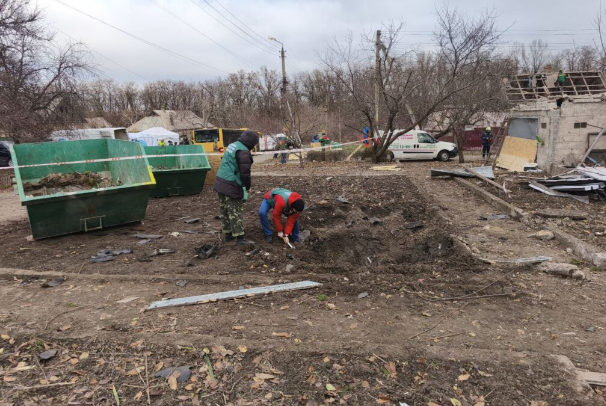How shelling with “shaheeds” and shells affects the ecology in Zaporizhzhia

Thousands of people die due to explosions and shelling, and the same irreparable losses are caused to the environment. As a result of artillery shell explosions and their fragments entering the soil and water, land and water resources are polluted and clogged.
Shells are deadly not only to people, but also to nature.
Each rocket or “shaheed” carries fuel, electronics, explosives and a detonator, which release toxic substances into the atmosphere when exploded, notes the head of the public association “Ekosense” Tetyana Zhavzharova.
“Even if a rocket or “shaheed” is shot down, these substances enter the air, soil and water, pollutants gradually accumulate,” she notes.
During the last shelling of Zaporizhzhia on the night of November 24-25, 2024, ecologists recorded significant damage: large craters were formed, and more than 1,700 m² of the territory was littered with debris.
“The exact composition of rocket fuel often remains unknown, as the military keeps this data secret. This creates an additional problem: we cannot accurately assess how it affects the environment and how to clean the soil. Typically, rockets use solid fuel based on nitrates, polymers and organic solvents, but its chemical composition can vary significantly depending on the type of rocket,” the ecologist notes.
According to her, during the explosion or combustion of such fuel, harmful substances such as carbon monoxide, nitrogen oxides, heavy metals, and lead are released into the atmosphere.
“All this gets into the soil, water and air, polluting the environment and posing a threat to the health of people and animals. A separate problem is that these compounds can remain in the soil for decades, causing chronic poisoning of ecosystems,” emphasizes Tetyana Zhavzharova.
Zaporizhzhia is also often attacked by “shaheeds”. After shelling and shooting down, there are many fragments of the hull made of composite materials that do not decompose naturally, the ecologist notes:
“Their engines run on fuel containing toxic petroleum products, which during an explosion or combustion get into the air and settle on the ground. Of particular danger are the combustion products of the drone’s electronic components, which emit dioxins, heavy metals and other toxic substances. All this pollutes the territories, creating risks for people and nature. In the places where “shaheeds” fall, significant debris and chemical pollution are often recorded, which is difficult to remove or neutralize. All this increases the level of danger to people caused by war.”
The head of the public association “Ekosense” notes that fresh craters from shelling often contain remnants of explosives, fuel and other toxic substances that can cause burns, poisoning or serious allergic reactions. Unexploded ammunition or detonators that can detonate when pressed or hit may also remain in the craters.
The ecologist calls not to approach craters and fallen ammunition without special equipment, high-level respirators, protective clothing, so as not to harm your health.
“Environmental restoration should become part of a comprehensive strategy for overcoming the consequences of the war in the Zaporizhzhia region and Zaporizhzhia in particular,” Zhavzharova notes.
Ecological damage is growing.
As of the end of November, the contamination of the lands of the Zaporizhzhia region since the beginning of the full-scale invasion is 314,138 m2, the State Ecological Inspectorate of the Southern District reported in a comment to Inform.zp.ua.
The damage caused to the environment is: Air – over 229 million UAH; Soil – over 16.6 billion UAH; Water – 3.7 million UAH.
The total amount of environmental damage in the Zaporizhzhia region during the full-scale invasion is 18,218,533,949 UAH. These are only the damages that are calculated on the territory controlled by the Ukrainian authorities.
Almost after each shelling of the city, specialists from the State Ecological Inspectorate of the Southern District travel to the affected areas to record the consequences and further carry out calculations. Ecologists also determine the area of contamination by fragments of rocket parts and shells. If ammunition has fallen into the soil, inspectors take samples for laboratory tests.
Specialists of the instrumental and laboratory control department determine the following pollutants: heavy metals (cadmium, copper, nickel, lead, chromium, zinc), nitrates, sulfates and petroleum products.
“For all pollutants, exceeding the maximum permissible concentrations of hazardous substances in the soil is detected. Exceeding the limits of pollutants in the soil can lead to negative both environmental and non-environmental consequences, because soils do not have the ability to be quickly cleaned. Chemical pollutants can remain in it for many years and be included in ecological chains. In the event of soil saturation with heavy metals and other pollutants, the soil can become a source of secondary pollution for water bodies, atmospheric air, animal feed and human food,” the State Environmental Inspectorate of the Southern District emphasized.
After conducting research around the areas littered with explosive device fragments, all the results obtained are included in criminal proceedings in order to further recover damages from the Russian Federation.
